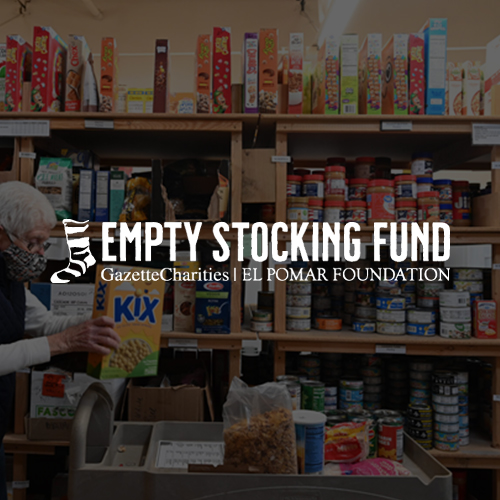
Food insecurity increases significantly in Colorado Springs
By Debbie Kelley debbie.kelley@gazette.com | Dec 4, 2020 Updated Dec 10, 2020
Food insecurity doesn’t mean opening the refrigerator and eyeballing a few condiments, a can of pop and a container of questionable leftovers because a trip to the grocery store or a home delivery hasn’t happened recently.
Food insecurity is not having the means to consistently provide enough food for everyone in the family to eat nutritious meals. Hunger pangs also can be exacerbated by lacking a car to get to a grocery store or not knowing how to locate a nearby food pantry.
Before the pandemic, one in nine Pikes Peak region residents were experiencing hunger on a regular basis, according to Care and Share Food Bank for Southern Colorado.
The number is projected to have worsened to one in six, said Joanna Wise, spokeswoman for Care and Share. And the need is increasing daily, she said.
Fifty percent more food went out the Care and Share doors from March through November over the same time frame last year, the organization reports.
“More children and families are facing hunger because of COVID-19,” Wise said. “We are seeing more people reaching out to our food bank for the first time — individuals who have been laid off or have had their hours reduced at work.”
El Paso County’s overall food insecurity rate is projected to be 14.4% this year, according to Feeding America, the largest hunger-relief organization in the United States. That’s up from 10.9% in 2018. Nationwide, the organization estimates 50 million Americans, including 17 million children, will face food insecurity this year.
Food insecurity had dropped in 2019 to its lowest rate since before the 2008 recession, with 35 million people, or one in 10 households, unable to provide sufficient, nutritious food for their families at times last year, according to a report from the U.S. Department of Agriculture.
Food pantries will receive $5 million in new COVID-19 relief aid from Colorado lawmakers, who on Wednesday approved a total of $280 million in emergency assistance measures.
Grant funding helped Care and Share purchase a truck and turn it into a “Mobile Market.” Like a grocer on wheels, the truck goes into neighborhoods that have high concentrations of need, such as senior mobile home parks.
Care and Share also is opening its first owned and operated food pantry, called Sunny Side Market, on the east side of Pueblo.
Westside CARES, a Care and Share partner that operates four food pantries, has seen nearly triple the number of people seeking food assistance at its popular Westside Community Center location, said CEO Kristy Milligan.
In October, the pantry served just over 900 people, compared with 395 people in October 2019.
“COVID-19 has had a significant impact on food insecurity,” she said, leading many pantries to temporarily or permanently close.
“At our pantry, we ask neighbors whether their visit is in any way related to coronavirus, and many of them report that it is: that someone has lost wages or is caring for youngsters or a sick person, or that their usual food-procurement plans have been displaced by the pandemic,” Milligan said.
To help meet demand, the organization eliminated caps on how often people can receive food through the end of this year and also started a delivery service.
In-kind donations have been essential in keeping the pantries open, Milligan said.
“There are certain items, such as jelly, jam and pasta sauce, that are hard for Care and Share to get,” she said. “Every week we publish a list of our most-needed items, and community members have been generous in bringing us those items that we cannot get elsewhere.”
The amount of food distributed through Tri-Lakes Cares in Monument, another Care and Share partner, has doubled since mid-March, said Christine Bucher, director of development.
In October, the pantry distributed nearly 8,000 pounds of food to 520 people, compared with nearly 3,900 pounds of food to 201 people in March.
Households receiving additional services, such as rent or utilities assistance, medical care and transportation aid, jumped from 18 households in March to 41 new households enrolling for services in October, Bucher said.
From grocery store shelves being emptied by panic buying and hoarding early on in the pandemic to now, “Our shelves have not been empty, and we are able to fill the grocery needs of our clients,” she said.
Clients complete a grocery order form and select needed staples, frozen meats, cleaning supplies, personal hygiene products, fresh produce, frozen meals, dairy, bread and bakery items.
While the organization received $275,147 in COVID-relief funding, which was used to purchase food for the pantry and help clients with rent or mortgage payments, the money cannot be used for car repair, medical care and prescriptions, clothing vouchers or costs associated with program operations, Bucher said.
“This is why the Empty Stocking Fund is so important — it is unrestricted dollars, which we can use where most needed,” she said.
As COVID-19 continues to impact the community, food insecurity will continue to be a challenge, Bucher believes.
“There is also the real possibility that donor fatigue will set in and donations of financial contributions and in-kind donations such as food will decline.”
Photo courtesy of Tri-Lakes Cares: Pat Murphy, a volunteer at Tri-Lakes Cares, picks out food at the pantry for a family of seven.